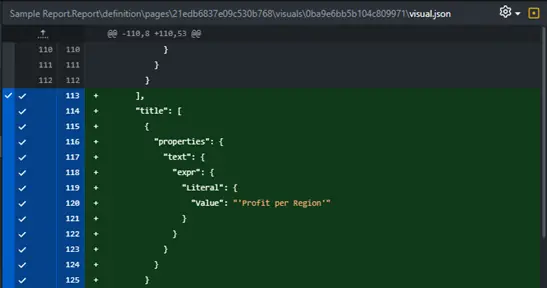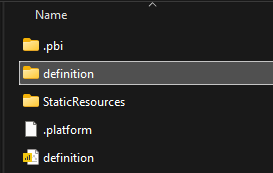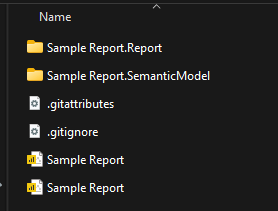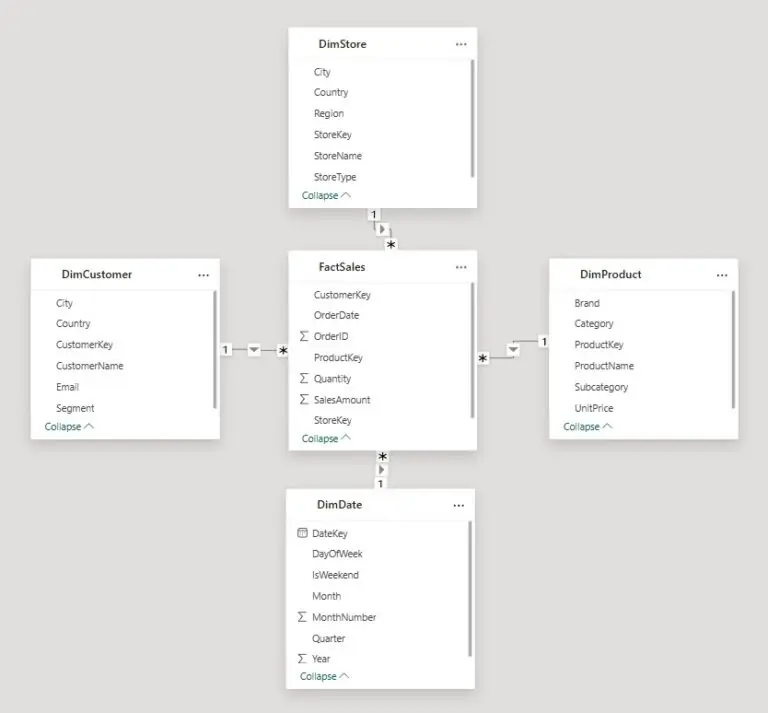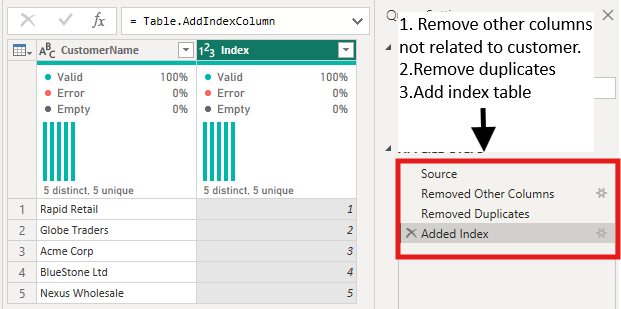
Power BI’s Enhanced Report Format (PBIR)
Contents
What if Power BI was more collaborative?
Imagine being able to track every change made to a project in Git and deploy reports seamlessly through Fabric pipelines.
Think about what would be possible if you could collaborate on Power BI projects with your whole team!
That’s exactly what Microsoft’s Enhanced Report Format (PBIR) makes possible.
PBIR is more than just a new file format.
Trainer Insight: On our London training courses, we will absolutely be teaching these new techniques.
Allowing a team to work together seamlessly is so beneficial, and should be applied whenever possible!
With the latest update, PBIR is moving from experimental preview into a practical, enterprise-ready standard.
For Power BI developers and BI managers, this is gamechanging.
It unlocks CI/CD pipelines, REST API integration, and Git-friendly project collaboration.
What is PBIR?
PBIR (Power BI Enhanced Report Format) is a JSON-based representation of a Power BI report.
- PBIX: Binary, all-in-one, not Git-friendly
- PBIR: Text-based, diff-friendly, ideal for version control
- PBIP: Folder-based project combining report + model
Why it matters: JSON formats are easy to track in Git, allowing teams to collaborate without overwriting work.
It shows which lines have changed, and updates people when a file has been edited.
What’s New In The Update?
Microsoft recently expanded PBIR’s capabilities:
- Fabric Deployment Pipelines – Push PBIR reports through Dev → Test → Prod
- Save a Copy in Power BI Service – Easier collaboration with business users
- Usage Metrics Integration – Monitor PBIR reports alongside PBIX
- REST API Support – Automate deployments in CI/CD workflows
Trainer Insight: For us, the most exciting addition in this update is the Fabric deployment pipelines.
In practice, this means teams can apply the Dev → Test → Prod workflows that developers have been using for years.
This will dramatically improve reliability and reduce risk when rolling out new reports.
Comparing File Types
| Format | Purpose | Pros | Cons | Best Audience | Typical Use Case |
| PBIX | Standard user workflow | Familiar, all-in-one | Not Git-friendly | Analysts | Ad-hoc reports |
| PBIR | Developer-friendly JSON | Git diffing, REST API support | Requires dev skills | Dev teams | CI/CD pipelines |
| PBIP | Full project structure | Complete dev workflow | More complexity | Enterprise BI | Multi-developer projects |
Here is an example PBIP folder, containing a definition folder that has all the structured information for the project.
Sample Downloadable Files
To make this hands-on, here are sample files using a simple Sales dataset (~200 rows):
- SampleReport.pbix – A traditional PBIX file
- SampleReport.pbir – The same report in JSON format
- This is under Sample Report.Report folder, file name is definition.
- SampleReport.pbip – The same report in project mode
These demonstrate how the same report looks across the different formats!
Download them all from this Google Drive folder.
Working with PBIR in Practice
1. Go to Settings > Options then Preview Features
Tick the box that says Store reports using enhanced metadata format (PBIR)
- What this does: This allows Power BI Desktop to save reports in the new JSON-based PBIR format instead of the traditional PBIX.
- Why it’s helpful: Unlike PBIX, PBIR separates metadata into a structured, text-based format that’s easy to read, track, and version-control. This is the foundation that makes Git, automation, and collaboration possible.
2. Git Integration: Commit PBIR to a repo. The JSON changes will be visible line by line.
Access the files using Git.
- What this does: Git can show exactly which lines of code or configuration changed between versions.
- Why it’s helpful: This eliminates the “black box” problem of PBIX, where you can’t see what changed without opening the file. It’s much easier for developers to review changes, roll back mistakes, and keep track of report evolution.
Trainer Insight: A common sticking point for delegates is understanding the real benefit of Git integration.
Once they see that PBIR shows exactly which line has changed in a JSON file:
They immediately grasp how much easier this makes collaboration.
When you access the files through Git, you should see the .gitattributes and .gitignore files.
Make changes on the powerbi file and then save it again as PBIP/PBIR.
Now when someone else goes to open the file, they will see all the lines that have been added or changed highlighted.
3. Fabric Pipeline: Deploy PBIR through Fabric deployment pipelines, moving them across environments.
- What this does: Pipelines manage the flow of reports through different stages of the BI lifecycle
- Why it’s helpful: This brings DevOps practices to Power BI. Teams can test changes safely before pushing them live, ensuring consistent, stable deployments and reducing the risk of errors in production.
Please Note! Fabric Deployment does require Power BI Premium – we have a breakdown on Power BI’s different versions and their pricing if you need to know more.
4. REST API Automation: Automate publish with PowerShell + REST API
Automate publishing PBIR files using the Power BI REST API in combination with PowerShell scripts.
- What this does: Developers can write scripts that upload, update, or refresh PBIR files without manual steps.
- Why it’s helpful: This is crucial for CI/CD pipelines, where you want automated, repeatable deployments. It saves time, reduces human error, and integrates Power BI into modern development workflows.
5. Collaboration: With PBIR files in Git, multiple developers can edit, review, and merge changes safely.
- What this does: Developers can work on different parts of the report simultaneously (e.g., one editing visuals, another adjusting DAX measures). Git manages merging changes together.
- Why it’s helpful: This makes Power BI development behave more like software engineering projects. Teams no longer need to “take turns” with a PBIX file — they can collaborate in parallel, improving speed and teamwork while keeping version history clean.
Common Use Cases
- CI/CD Pipelines – Automate report promotion
- Version Control – Track and roll back changes in Git
- Collaboration – Multiple developers can work safely on the same report
- Testing Environments – Validate changes before going live
Pitfalls & Limitations
- Technical Skills Needed – Requires JSON and Git
- Not Analyst-Friendly – PBIX is easier for business users
- Dependencies – Best used with Fabric pipelines and REST APIs
Future of PBIR & PBIP
Microsoft’s roadmap suggests PBIR will soon be generally available.
Currently, anyone can turn it on (as we showed earlier in the article) but it’s more of a preview.
Expect to see some changes and updates as time goes on.
This aligns with a broader developer-first strategy in Power BI.
Trainer Insight: We often run have teams that have issues working together, as Power BI usually forces a “one-at-a-time” approach.
The move to PBIR and PBIP makes true collaboration possible.
It allows multiple developers to work in parallel, tracking changes and resolving conflicts.
Conclusion
PBIR is not just a new file type – it’s a new way of working!
By adopting PBIR, BI teams gain:
- Git-friendly workflows
- CI/CD automation via Fabric
- REST API integration
- Future-ready enterprise governance
Now is the time to start testing PBIR alongside PBIX and PBIP.
Learn how to do it and prepare your team for the developer-first future of Power BI!
- Facebook: https://www.facebook.com/profile.php?id=100066814899655
- X (Twitter): https://twitter.com/AcuityTraining
- LinkedIn: https://www.linkedin.com/company/acuity-training/
